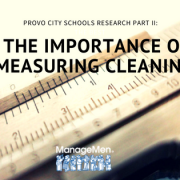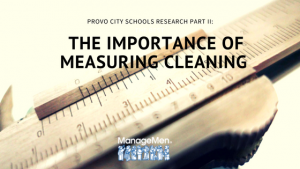How You Can Use Data to Reduce the Threat of Outsourcing
Like it or not, we live in an age where data rules. So much, in fact, that the term “big data” has become more than just a buzzword, it’s central to the way businesses operate. Each day, billions of data bytes are collected as businesses track what we’re buying, where we’re going, what we’re watching and how we’re using the internet. Businesses use this data to better target their advertising and products with the ultimate goal of growing sales.
On the operational side, organizations also amass vast data banks related to all aspects of their business. This includes information about their supply chain, logistics, inventory and labor. This data is regularly analyzed to increase efficiencies, identify opportunities and improve margins.

Organizations that fail to produce data related to their cleaning operation run the risk of being outsourced.
That’s why when cleaning professionals neglect to collect and track data related to their operations, they ultimately fail. This failure can result in significant downsizing—or outsourcing.
Here’s a scenario we see too often:
Jim has managed a cleaning department for more than 15 years. Over this period, much of the cleanable square footage has remained the same, so Jim has maintained the same number employees to clean that space. While he’s had a few cuts, his budget has also remained largely unchanged over the years. He makes purchases based on recommendations from his distributor sales rep and previous purchase histories.
Enter Robert. Robert is the new CEO of the business where Jim works. In his first two weeks on the job, Robert meets with all the department managers to get a better understanding of the business. He asks Jim questions like, “How much time and chemical does it take for your team to clean the cafeteria?” and, “How would changing cleaning frequencies impact cleanliness?”
Jim broadly answers the questions, providing estimations based on his experience. But Jim can’t tell Robert that it takes two people on his team 42 minutes to clean the cafeteria using .5 ounces of all purpose cleaner concentrate. Jim doesn’t have this data.
We all know how the scenario plays out. Not long after the meeting ends, Jim’s department is outsourced to a contract cleaning company who promises more for less. While the quality of cleaning plummets, it takes Robert and his executive team to realize the impact cleanliness has on both their customers’ experience and the productivity of the workers in their headquarter offices.
Developing Data through Workloading
Workloading your operations can product significant data related to your cleaning program, and it doesn’t require assistance from a consultant or someone who claims to know a secret formula. You can do it yourself. In fact, we’ve just wrapped up a crowd-sourced workloading project that includes 99 common (and benchmarked!) workloading times along with formulas you can use to workload your operations. Feel free to check out the booklet here, which will soon be released in a comprehensive do-it-yourself kit. But more on that later.
Really, the key to workloading is just understanding and working through a few relatively simple steps:
- Complete a thorough inventory of the space to be cleaned. Rather than using the gross square footage of the building, it’s best to walkthrough the building and manually calculate the cleanable square footage. This will help ensure the accuracy of the data and avoid skewed figures.
- List the cleaning tasks to take place. You should break down tasks into three categories, including daily, detail and project. Sample tasks may include empty trash, dust all horizontal surfaces, vacuuming, spot clean glass, etc.
- Calculate the time necessary to perform the tasks. There are thousands of variables that can impact cleaning times, but unless plan on conducting your own time and motion study, you can start with the times provided in the 612 Cleaning Times Booklet.
- Begin workloading the data. Begin by developing a chart that identifies the frequencies, tasks and the time performed for each task. For example, a daily task, such as dusting, may be performed 260 times per year where scrubbing flowers may be done once a month, or 12 times a year.
Next, allocate the amount of time for each task to the appropriate square footage. Then, add non-surface items per unit to be cleaned. In your final step, you should calculate the time for each task and multiply multiply that by the frequency. This number should offer a clear picture of the amount of time and labor required to clean your facility.
Ultimately, the formula is to take the task and multiply it by the time (required to perform the task), then multiply that number by the frequency. The final calculated number is your basic workload.
TASK x TIME x FREQUENCY = WORKLOAD
This piece of data is just one of several you should have in your pocket should “Robert” show up at your business and schedule a meeting.
Click here to receive your copy of our DIY Workloading Guide and stay tuned for more information our complete DIY Workloading Kit, coming soon!
SaveSave



